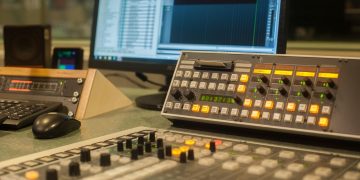
The Junior Reserve Officers Training Corps (JROTC) marksmanship program ended last week for Mission Bay High, Point Loma High and students across the school district. College and high school student demonstrators waved signs both celebrating and decrying JRTOC rifle ranges on campus, lining the hallways and grassy area of the Eugene Brucker Education Center during a contentious San Diego Unified School District board meeting Tuesday, Feb. 10. Board members voted 3-2 in support of parent and student demonstrators’ movements to remove air-pellet guns from campus in light of recent off-campus shootings involving high school students. Board president Shelia Jackson and board member Katherine Nakamura voted to keep the JROTC marksmanship program open. Board members John de Beck, John Lee Evans and Richard Barrera voted to close the firing ranges, effectively ending the marksmanship portion of the program. During the meeting, board members praised the students’ peaceful demonstration that included about 100 Lincoln High School students, community organizers and parents. Lt. Col. Brian Josten, Mission Bay High’s JROTC instructor, said his students were disappointed with the school board’s decision. “What did the demonstrators gain?” Josten said. “I sure know what we’ve lost, but what was gained?” Mission Bay High principal Cheryl Seelos said a lot of hard work and requests from students brought the Marine Corps JROTC marksmanship program to Mission Bay High about a year ago. Debate swirled over the program and potential conflicts with the San Diego school district’s “zero tolerance” policy regarding weapons on campus. “It’s a collegiate sport and has nothing to do with killing people on the street,” Seelos said. “We’re going to fight this [school board decision].” The air rifles use 177-caliber pellets that are slightly bigger than the more common BB used in most air pistols, JROTC officials said. An estimated $65,000 set aside for the program helps pay for staffing. The Marine Corps pays for the rest of the Mission Bay High program, including the cost of rifles and safety equipment, Seelos said. Despite getting rid of the rifles and ranges, the rest of the program remains intact. School district board members voted to allow the program to fulfill physical education graduation requirements along with the school’s marching band program. Point Loma High School principal Barbara Samilson said her school was caught off guard by the school board’s vote on the marksmanship training. “We were definitely taken by surprise,” Samilson wrote in an e-mail. “[JROTC marksmanship] teaches self-discipline, the value of hard work and practice and the value of working as team.” Representatives of Education Not Arms Coalition said at the meeting that the JROTC in high schools acts as a military recruiting tool. They said students were often encouraged to join the JROTC at schools throughout the district. Seelos said students are not “tracked” into the Mission Bay program and that the school offers the course as an elective requiring parents’ permission. Rich Jahnkow, a coordinator for the Project on Youth and Non-Military Opportunities, said having air rifles on campus sends the wrong message to students. “[Students and parents] felt it was inconsistent with the philosophy of the district to try to encourage students to not think about using violence to solve problems,” Jahnkow said. “So they felt that these [ranges] did not belong.” Former Mission Bay High School student Zulema Torres, 33, joined several students and parents from the Education Not Arms Coalition at the school board meeting. The coalition represents Latino and education groups, including the Association of Raza Educators and local high school chapters of the Movimiento Estudiantil Chicano de Aztlan (MEChA), a student political group. “Many parents send their children to school … so they could get an education, not so they can learn to shoot weapons,” Torres said. College students also joined the debate face to face outside the school board meeting. California College Republicans representative Matthew Donnellan, 21, rallied alongside former and current high school student supporters of the JRTOC program and said that those against the program are misinformed. “The JROTC shapes students to be leaders. It’s safe and supervised,” Donnellan said. Former San Diego State University MEChA president Luis Fuentes, 25, said high school should be a place to learn and “not train students to shoot” weapons. About 81 students enrolled in the Mission Bay High School Marine Corps JROTC program last year, according to Josten. The entire district had an estimated 2,000 cadets last year. The JROTC program’s 80-year history in San Diego schools show an impeccable safety record, Josten said, with zero accidents reported during its time at Mission Bay High. The school district has had the JROTC program in high schools since 1919. San Diego High School was the first school to offer the program. Mission Bay High had an Army JROTC before officials moved the program to Madison High in 1962.












Discussion about this post